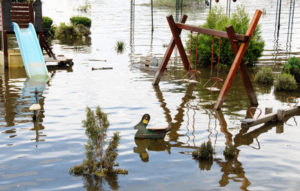
Wildfires, tornadoes, floods and hurricanes–weather has dominated the headlines in recent months. Disaster strikes with heartless intensity. Even a single death is one too many. Mother Nature can exact a crushing toll. Though many of the losses are material and replacement can eventually be made given enough money and time, the losses are still heartbreaking, discouraging, and frightening. Many significant losses cannot be measured in dollars and cents because the destruction destroyed things of intrinsic or sentimental value. But beyond measure are the losses “without price” –intangibles like peace of mind, souvenirs and photographs of life’s milestones. Another huge loss is one’s sense of safety and permanence.
Unable to prevent these natural disasters, we watch in horror. News coverage appears on a range of devices that keep us constantly updated and agitated. The scale and frequency of bad news can overwhelm us and can lead to compassion fatigue. Or, it can tempt us to throw our hands up in despair, do nothing and simply take our chances. As Intentional Parents, we understand and appreciate the value of planning ahead, of predetermining our responses as a way of reassuring and protecting our families.
Adopted children may be especially vulnerable to anything that threatens their sense of continuity and permanence. Having already experienced a profound loss–the loss of their first family–they may feel a strong need to hang on to “stuff” as a way of imposing some sense of control or “insurance.”
 Sentimental pack rats may hate to part with items that may seem trivial to us. Avoid dismissing or belittling their desire to preserve memories. These items may provide them with essential ballast for steadying them through uncertainty. Help them discern why and what they want to save. Respect their inclination to save “stuff” and help them find ways to organize and curate their “collection.”
Sentimental pack rats may hate to part with items that may seem trivial to us. Avoid dismissing or belittling their desire to preserve memories. These items may provide them with essential ballast for steadying them through uncertainty. Help them discern why and what they want to save. Respect their inclination to save “stuff” and help them find ways to organize and curate their “collection.”
When disaster hits the headlines, our kids absorb the news (even if only peripherally.) All the dramatic coverage may cause them to feel a thrum of anxiety and uncertainty. They may not even suspect this is what makes them feel so unsettled. As adults, we too may be triggered by the pictures of flooded homes, collapsed dams, and houses floating down neighborhood streets. We hope our homes will be sturdy and remain undamaged and that our families will be safe. We may wonder if we have enough insurance, an adequate Emergency Fund or sufficient stockpile of emergency supplies. We may worry about potential damage, lost wages, and repair costs
We may unconsciously telegraph our own fear to our children. Consider holding a family meeting. In the absence of reassuring conversations, their fears may overwhelm them. Talk about what is occurring. Inform children of the preparations you’ve made, etc. Let them know how they can help. Invite them to pre-select what they would want to pack and preserve in case of a weather emergency. Explore how you can help neighbors and others in the community.
Ideally. hold these conversations when circumstances are calm, before danger looms. Ask kids to talk about their fears as well as their ideas for solutions and strategies. The conversation may even lead to children sharing other concerns and fears not related to storms but equally or even more important to discuss.
How might your family benefit from talking about disaster preparedness?
https://wp.me/p4r2GC-22z




I totally get that one’s sense of order could conflict with their child’s need to hang on to what might otherwise be considered “outdated” possessions. It’s important to look at your own priorities and perhaps realign them so that the security your child seeks is enhanced. For some of us, it might be more difficult as we are “neat niks”! #adoption, #adoptiveparenting, #adoptivefamilies, #AAQ, #adoption-attunment
Yes, it can be challenging. It may help create a compromise if we can understand how and why one attaches importance to something.